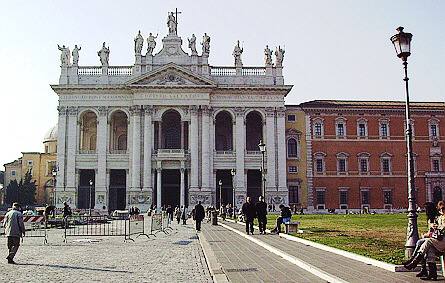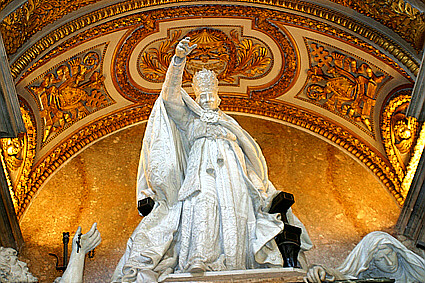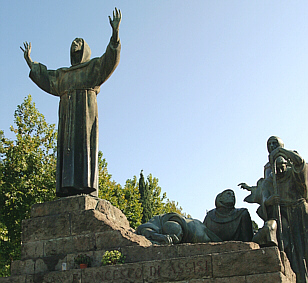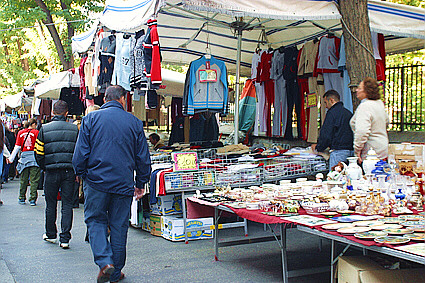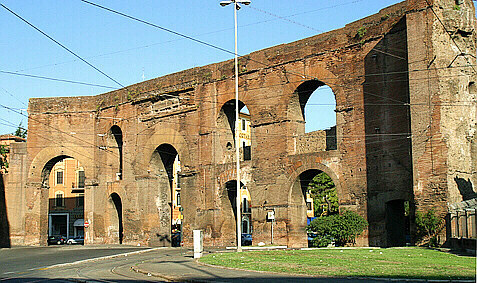St. John Lateran, Holy Cross of Jerusalem, Holy Stairs
- early Rome Christian churches, monuments and sights near Monti -
- Monti: the quarter of Saint Peter
- Basilica of Santa Maria Maggiore (St. Mary Major)
- San Pietro in Vincoli (St. Peter in Chains), the Moses of Michelangelo
- The many other churches and basilicas in the quarter
- Other monuments and sights in the quarter
- Streets, Piazzas and life in the quarter
- Restaurants, Cafes, and Shops
- St. John Lateran, Holy Cross of Jerusalem, Holy Stairs near Monti (this page)
|
In addition to the many important churches and monuments in the heart of the Monti quarter, around it you find churches and sights which are of paramount importance in the history of the wester world. Firstly, St. John Lateran (San Giovanni in Laterano).
St. John Lateran (San Giovanni) basilica, the facade, and the square Right: Interior, the Gothic papal canopy (baldaquin). It contains a wooden altar supposedly used by the early popes, from St. Peter to St. Sylvester, to celebrate Mass. It also includes silver busts with remains of the skulls of St. Peter and of St. Paul. )
|
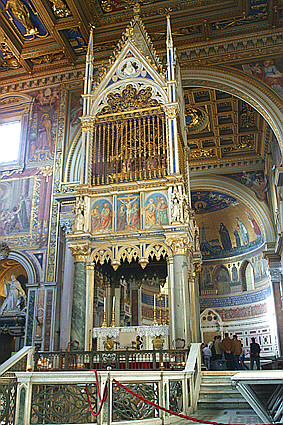 |
It was the first church which the Christians were enabled to build, having granted the permission from emperor Constantin, who also converted to Christianity, and who legalized Christianity with the Edict of Milan of 313 AD. The church was built in the most peripheral area within the Aurelian walls, today part of Rome's centre. You will find below a photo of the ancient Appian Gate of the walls, near to the church. St. John Lateran (San Giovanni in Laterano in Italian) is one of the few "Patriarchal Basilicas" which are part of the Vatican City, although they are out of the Vatican area. The others are St. Mary Major, Holy Chross of Jerusalem, and St. Paul out of the Walls. Three out of four of these basilicas are situated in the Monti-Esquiline area.
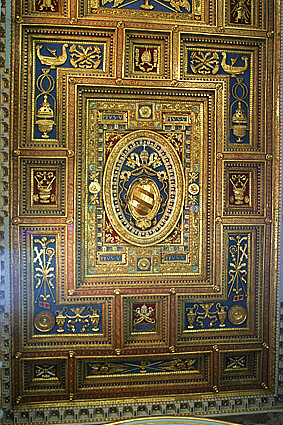 |
The Basilica of St. John Lateran is the official ecclesiastical seat of the Bishop of Rome, who is the Pope. It is run though by a Cardinal who is vicar of the Pope (currently, Cardinal Ruini). The main front bronze door is that of the Curia, or ancient Rome's senate. The church was re-built many times because of natural disaster, and its final renovation and facade are work of architect Alessandro Galilei, and were finished in 1734. In the entrance you find the original ancient statue of emperor Constantin, found in the imperial termhae near of the Quirinal hill. The coffered ceiling (left photo), gilded with real gold, is together with St. Mary Major's the most amazing of all Italian churches. It is said that the first gold which arrived from the newfound Americas were used for the roof. It is the work of pupils of Michelangelo, and it was finished in 1562 AD. The wonderful mosaic in the apse (right photo) shows Jesus while the apostles in the foreground. Many popes are buried in the basilica. |
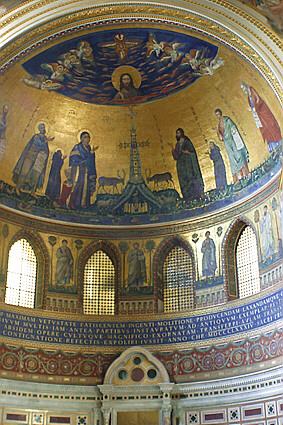 |
|---|
The estate of this area was acquired by Constantin though his marriage with Fausta (emperor Maxentius' sister). Soon after, the Emperor razed the adjoining imperial horse-guards barracks (allegedly the equites singulares had supported Maxentius against Constantine) and commissioned on the site the construction of the world's first Christian basilica.
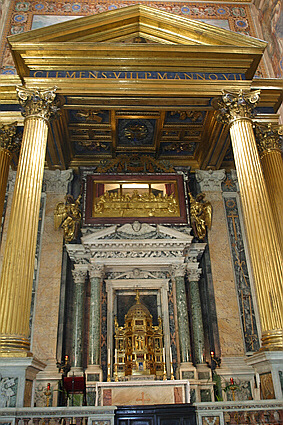 |
The grave of Pope Leo XIII (Left): the altar with the wooden table supposedly |
|---|
Entering the transept, we pass to the sixteenth-century Mannerism. Pope Clement VIIIemployed his favorite architect, Giacomo della Porta, and painter, Cavaliere d'Arpino to direct the works, deploying the top Mannerist painters of the day. They executed a series of frescoes around the entire left and right transepts, telling the story of Constantine and St. John Lateran. On top of an altar on the left side of the transept you find a wooden table which according to tradition was used by the Apostles for the last supper.
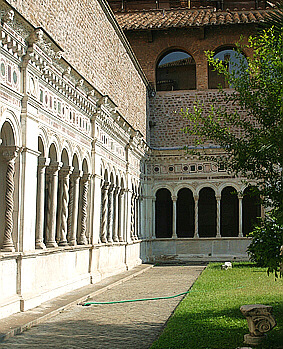 |
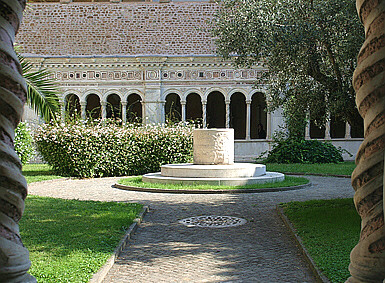 |
|---|---|
The beautiful 13th century cloister it is the work of Pietro Vasselletto and son. As it is typiucal of their work, you find jewel-like mosaics, elegant arches with paired spiral and smooth columns, and finally odd animal and floral motifs. |
|
|
The bronze statue of St. Francis (top photo) and of his friars in front of the Church commemorates the visit of the saint to Pope Urban VIII. The Pope had been ill-advised by his counsellors to meet what they described as a radical preacher. The Pope instead admired his humility and faith. The Baptistery (right photo) , to the left of the St. John Basilica, was originally built by Constantine, and it was substantially restored by Pope Urban VIII. One of its doors is described in Dante's "Divine Comedy" to be the gate of Purgatory. It is extremely heavy and it makes a weard sound when moved. |
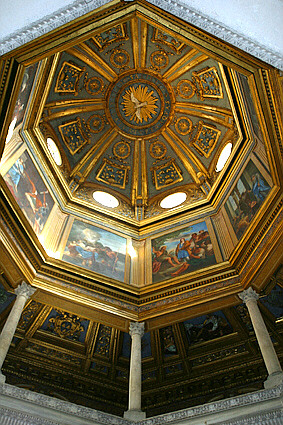 |
|---|
|
Adjoining the Basilica, you find the Lateran Palace (Palazzi Lateranensi). They are the seat of Rome's Diochesis, and also of many Catholic Churches organizations around the world. In fact, St. John as mentioned is the most ancient Western Basilica, and considered the mother of all Catholic churches. Rome's Bishop is the Pope, however the Diochesis is run by a Cardinal Vicar, who currently is Monsignor Ruini. It was formerly property of the ancient Roman patrician Laterani family (hence the basilica's appellation "Lateran"). They were accused by Nero of plotting against him and they were thus confiscated. After the building of the basilica by Constantin, the Lateran palace, known as the Patriarchate, was the Pope's official residence until the fifteenth century. Right: Lateran Palace |
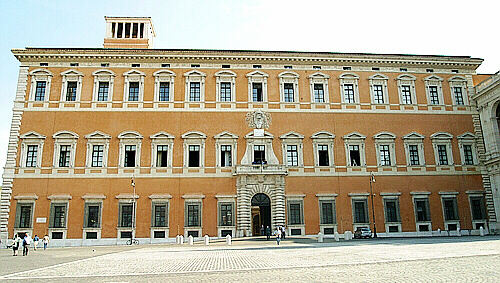 |
|---|
|
Near the Basilica you find the ancient Appian Gate of the Aurelian Walls (right photo). Nowadays it is closed to traffic, and it is an archaeological site only. It is also 3 meters below the current surface level, as it can bee seen in comparison to the current level of the nearby New Appian Way (Appia Nuova). Just after the gate, the popular Roman quarter called "San Giovanni" begins, with one of Rome's most charming street markets, situated in Via Sannio (top photo). |
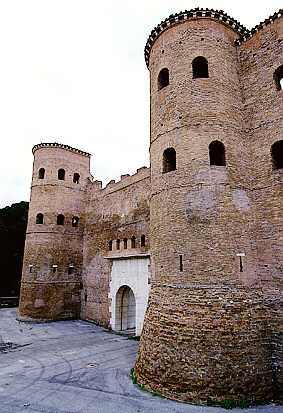 |
|---|
Only 400 meters distant you find the Basilica of Holy Cross of Jerusalem (Santa Croce in Gerusalemme). According to tradition, the basilica was consecrated around 325 AD to house the Passion Relics brought to Rome from the Holy Land by St. Helen, mother of Constantine. The basilica floor was covered with soil from Holy City, thus acquiring the title "in Hierusalem".
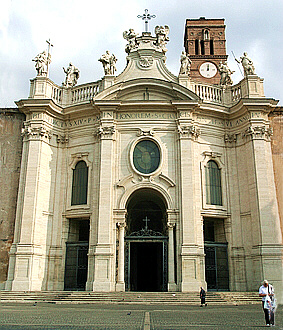 |
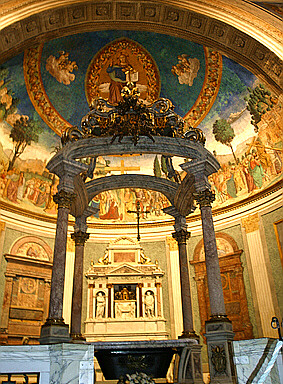 |
|---|---|
|
Holy Cross of Jerusalem: facade
|
Interior, the beautiful canopy
|
The famous relics, whose authenticity is disputed, are now housed in a Chapel (the Cappella delle Reliquie). They include: a part of the panel which was hanged to the Christ's Cross; two thorns of his crown: an incomplete nail; and three small wooden pieces of the Cross itself. A much larger piece of the holy cross was brought from this church to on instruction of Pope Urban VIII in the year 1629. It is kept nearby the statue of St. Helena, completed in 1639. You also find a finger of St. Thomas and fragments of the grotto of Bethlehem.
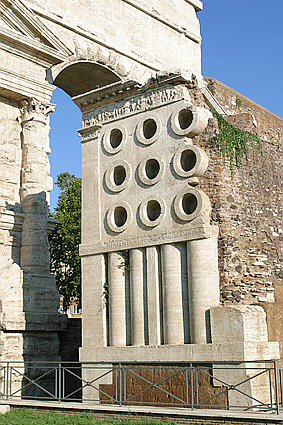 |
Near the Church of the Holy Cross you find the largest and most sumptuous of all the gates of the ancient Rome Aurelian Walls. It is hence called Porta Maggiore, or Major Gate (left photo).
Right in front of it you find a funerary monument of an ancient Roman baker or "Pistorium" (left photo) , probably a liberated slave. The monument has many mouths of ovens displayed, and also engravings depicting the bakers work and life. The majestic Appius Claudius aqueduct (top photo) reaches the Aurelian Walls exactly at Porta Maggiore. After a small tract, it reaches the "Castellum Divisiorum" or dividing castle, to clean and divide the water in various parts of town. It is situated in todays square "Piazza Vittorio Emanuele", and it is called "Trofei di Mario" from the statues which adorned it, which made archaelogists believe is was a celebrative monument. |
|---|
